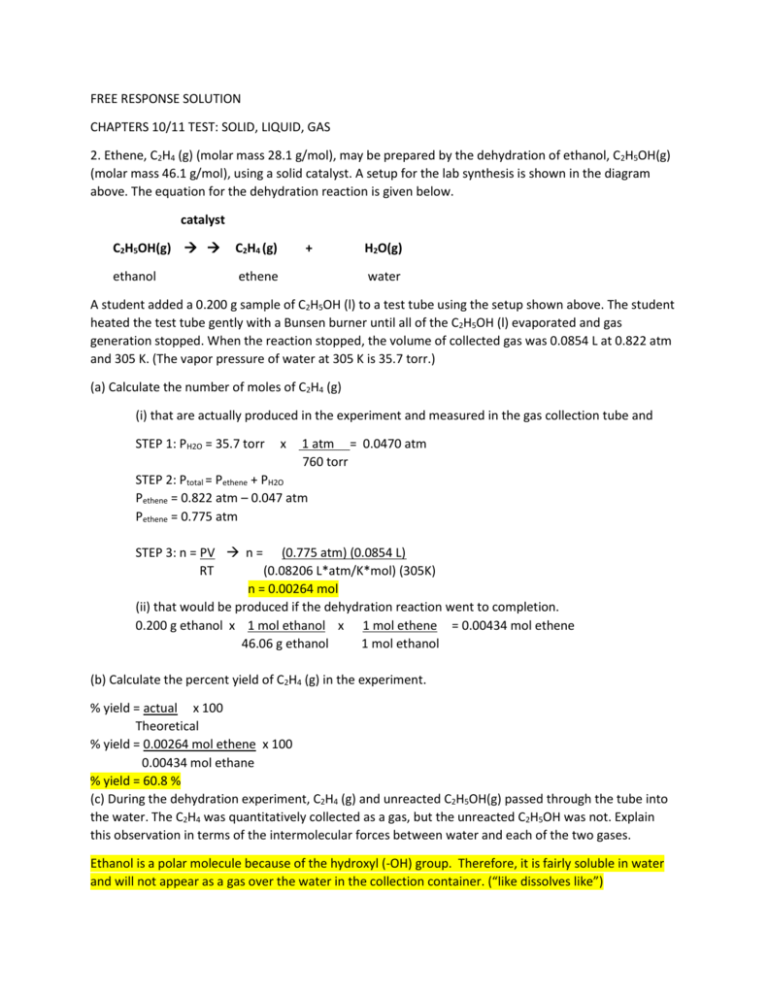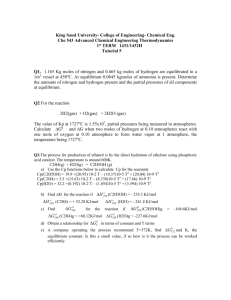FRQ #2 - My eCoach
advertisement

FREE RESPONSE SOLUTION CHAPTERS 10/11 TEST: SOLID, LIQUID, GAS 2. Ethene, C2H4 (g) (molar mass 28.1 g/mol), may be prepared by the dehydration of ethanol, C2H5OH(g) (molar mass 46.1 g/mol), using a solid catalyst. A setup for the lab synthesis is shown in the diagram above. The equation for the dehydration reaction is given below. catalyst C2H5OH(g) C2H4 (g) ethanol ethene + H2O(g) water A student added a 0.200 g sample of C2H5OH (l) to a test tube using the setup shown above. The student heated the test tube gently with a Bunsen burner until all of the C2H5OH (l) evaporated and gas generation stopped. When the reaction stopped, the volume of collected gas was 0.0854 L at 0.822 atm and 305 K. (The vapor pressure of water at 305 K is 35.7 torr.) (a) Calculate the number of moles of C2H4 (g) (i) that are actually produced in the experiment and measured in the gas collection tube and STEP 1: PH2O = 35.7 torr x 1 atm = 0.0470 atm 760 torr STEP 2: Ptotal = Pethene + PH2O Pethene = 0.822 atm – 0.047 atm Pethene = 0.775 atm STEP 3: n = PV n = (0.775 atm) (0.0854 L) RT (0.08206 L*atm/K*mol) (305K) n = 0.00264 mol (ii) that would be produced if the dehydration reaction went to completion. 0.200 g ethanol x 1 mol ethanol x 1 mol ethene = 0.00434 mol ethene 46.06 g ethanol 1 mol ethanol (b) Calculate the percent yield of C2H4 (g) in the experiment. % yield = actual x 100 Theoretical % yield = 0.00264 mol ethene x 100 0.00434 mol ethane % yield = 60.8 % (c) During the dehydration experiment, C2H4 (g) and unreacted C2H5OH(g) passed through the tube into the water. The C2H4 was quantitatively collected as a gas, but the unreacted C2H5OH was not. Explain this observation in terms of the intermolecular forces between water and each of the two gases. Ethanol is a polar molecule because of the hydroxyl (-OH) group. Therefore, it is fairly soluble in water and will not appear as a gas over the water in the collection container. (“like dissolves like”) Ethene is nonpolar because the bonds are only slightly polar (C= 2.4 and H = 2.0) and because it is a symmetrical molecule, which serves to effectively cancel the polarity of any individual bond. Since it is nonpolar, it will be virtually insoluble in water (water is polar.) Therefore, it will collect above the water in the collection container.








